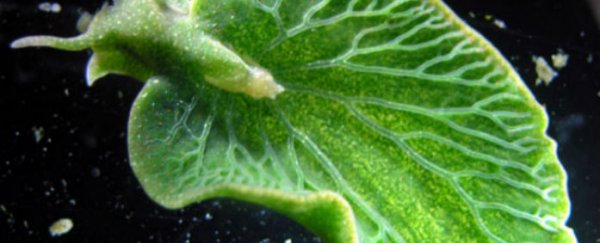After decades of searching, scientists have finally found direct evidence to show that the emerald green sea slug (Elysia chlorotica) takes genes from the algae it eats to perform photosynthetic processes, just like a plant. This means it can get all the energy it needs from sunlight, allowing it to survive without food for months.
"There is no way on earth that genes from an alga should work inside an animal cell," one of the team, Sidney K. Pierce from the University of South Florida in the US told Diana Kenney at the Marine Biological Laboratory Blog. "And yet here, they do. They allow the animal to rely on sunshine for its nutrition. So if something happens to their food source, they have a way of not starving to death until they find more algae to eat."
Scientists have known for over 40 years that the emerald green sea slug takes chloroplasts - organelles found in plant and algal cells that facilitate photosynthesis - from the yellow-green algae it eats, called Vaucheria litorea. Referred to as 'kleptoplasty', this process allows the chloroplasts to continue photosynthesising in their new sea slug home for up to nine months after transferring from the algae. By photosynthesising, the sea slug produces lipids when the energy from the sunlight is combined with water and carbon dioxide, which gives it all the nourishment it needs, no additional food required.
But exactly how the emerald green sea slug manages to maintain these organelles in working order for so long has proven to be a frustratingly complex puzzle - one that was not made easier by an experiment completed by researchers at the University of Dusseldorf in Germany in 2013. The team gave their emerald green sea slugs a drug that completely halted any photosynthetic activity in their cells, but the slugs still managed to survive for 55 days, without any food. As Marissa Fessenden explains at Smithsonian.com, they ended up a little smaller and paler, so food wouldn't have gone astray if they were offered it, but it was proof that the organelles they 'stole' from their last algae meal were somehow still working for them.
Which is super-strange, as Ferris Jabr explains for Scientific American:
"In order to photosynthesise, the chloroplasts inside an alga depend on many genes in the alga's own nucleus and the proteins for which they code. Tearing chloroplasts out of algal cells and asking them to make food inside a slug's gut is like expecting the bottom half of a blender to puree some carrots sans the blade and glass jar."
So where are these genes that the chloroplasts depend on? Pierce, and his colleagues, biologists Julie Schwartz and Nicholas Curtis, decided to find them once and for all. Reporting in The Biological Bulletin, the team used fluorescent DNA markers to track the genes from the algae as they made their way into the genetic material of both juvenile and adult emerald green sea slugs. And for the first time, they watched as these genes produced an enzyme that's critical to the proper photosynthetic function of the chloroplasts.
"This paper confirms that one of several algal genes needed to repair damage to chloroplasts, and keep them functioning, is present on the slug chromosome," Pierce told Kenney at the Marine Biological Laboratory Blog. "The gene is incorporated into the slug chromosome and transmitted to the next generation of slugs."
So while the young emerald green sea slugs still need to feed on the algae to get their supply of chloroplasts, the genes they need to turn these chloroplasts in to little photosynthetic machines have already been passed down to them from their parents.
"Importantly, this is one of the only known examples of functional gene transfer from one multicellular species to another, which is the goal of gene therapy to correct genetically based diseases in humans," Kenney reports.
Unfortunately though, sea slugs aren't exactly the best biological models for use in developing new medical treatments for humans - despite what you might think about your brother or creepy uncle, humans and slugs aren't exactly similar. But the surprisingly efficient mechanism of gene transfer that's being used by the emerald green sea slug is something that could be incredibly useful in medical research.
And what I want to know is, what does sunlight taste like, and can it make me grossly incandescent?
Sources: The Marine Biological Laboratory Blog, Scientific American, Smithsonian.com
